Shotgunning in the Automatic Mind: The Creation of the Most Beautiful Shotgun Instruction Book Ever Published
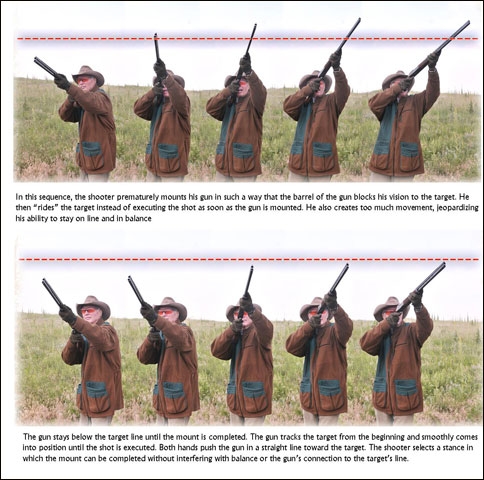
In 2001, Margaret Wilfley finally put her foot down. She was no longer going to be a bystander after watching her husband Mike and friends during a week in England shooting driven birds. She would learn shotgunning. Mike knew she meant it and years of marriage told him that he needed to find an excellent coach rather than try to teach her himself. Friends recommended Warren Watson. From the very first lesson, it was clear why.
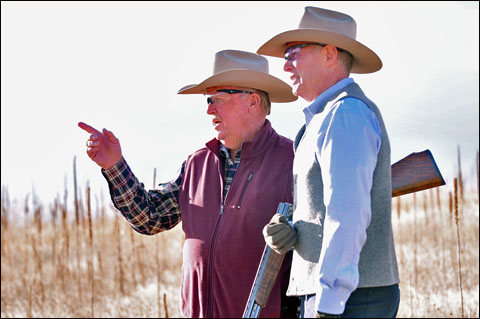 Mike Wilfley (foreground) with Warren Watson.
Mike Wilfley (foreground) with Warren Watson.It would turn out to be a fateful decision on Margaret’s part. That initial lesson with Warren Watson led to a 12-year collaboration between Mike Wilfley and Warren to produce what is perhaps the most beautiful book ever published on shotgun instruction titled “Shotgunning in the Automatic Mind – A Guide for Shotgunners and Instructors.”
Although many people have told Warren and Mike that it should be prominently displayed like a coffee table book, in fact “Shotgunning in the Automatic Mind – A Guide for Shotgunners and Instructors” is really intended to be dog-eared, marked up and probably get some gun-oil smudges on its glossy pages and gorgeous instructional diagrams. While the book’s high quality appears as cosmetic, its true mission is durability.
 On visual pickup points, you must determine the exact location where each target can first be seen (pages 81-82).
On visual pickup points, you must determine the exact location where each target can first be seen (pages 81-82).Watching Margaret get off to a great start with Warren, Mike was reminded of a couple of life lessons, beginning with the simple facts that a) he didn’t know nearly as much as he thought he did about shotgunning, and b) he wasn’t nearly as good a shotgunner as he thought he was.
“Sometimes you think you are good at something until you meet someone who is,” Mike said. “I continued observing the lessons and after each, wrote notes on new things I learned. Since that time, about twenty years ago, Warren and I shot and hunted together many times.”
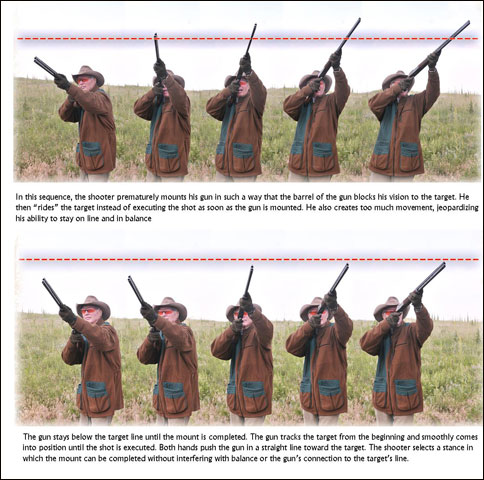 Vertical misses are often due to a poor gun mount or poor gun fit (page 42).
Vertical misses are often due to a poor gun mount or poor gun fit (page 42).One of the first things that impressed Mike about Warren was that he would have beginner students handle and point the gun and take practice “shots” without ammunition for a long time before taking a real first shot. And he wouldn’t have them take that first real shot until he was quite sure they would hit the target. Warren knew that an important part of the job was to put students at ease, take the fear away, convey the clear message that he was responsible for their comfort and safety. He would give students only what they needed on that day and not confuse them with more.
What Mike came to understand is that Warren keenly observed every facet of his students’ movements. Warren had extraordinarily sharp vision and could see exactly where the shots went, further helping analyze any situation. He would pick up on the tiniest details that might be interfering with progress and success. Warren made a point of listening to his students, drawing out from them important insights. Why are you here? What do you want to accomplish? He wanted to understand how they learned and he wanted to know about their experiences in life. All those things that were a part of them and would be brought to the shotgunning sessions. His approach was sophisticated, simple, and subtle.
 Learn to shoot with your Automatic Mind because it has no fear or doubt and executes instinctively (page 136).
Learn to shoot with your Automatic Mind because it has no fear or doubt and executes instinctively (page 136).As Mike would discover, one telling outcome of Warren’s training success is that 65 of his students progressed to Master Class Level Sporting Clays level.
At some point, Warren told Mike that for years he’d been trying to write a book based on his training process and it just wasn’t coming together. Intrigued by the idea, Mike created an outline to help Warren make progress, but this approach didn’t work. Eventually, they decided to work as co-authors, planning at first to write a small handbook.
When Warren and Mike eventually got down to the business of developing the book’s concept, it was a collaboration of different yet complementary skill sets.
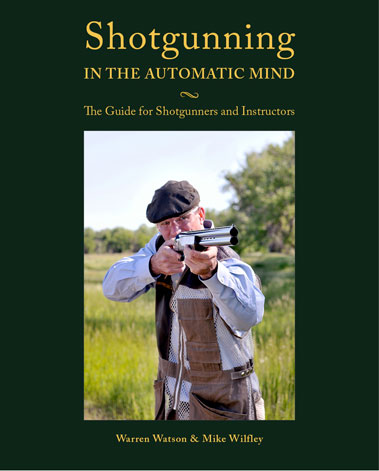 “Shotgunning in the Automatic Mind – A Guide for Shotgunners and Instructors.”
“Shotgunning in the Automatic Mind – A Guide for Shotgunners and Instructors.”Warren grew up in southern Illinois on the Mississippi Flyway, where shotgunning for waterfowl and bobwhite quail was a way of life. Since the 1990s, Warren has been a professional instructor and shotgunning competitor in tournaments all over the United States. After winning the Colorado Sporting Clays State Championship in 1999, Warren retired from competition to teach shotgunning full time, founding the Warren Watson School of Shotgunning near Denver, Colorado.
Mike, with a Juris Doctor and Master of Fox Hounds degrees, grew up in the outdoor sporting world of Colorado that included good guns and good dogs. He has always been intrigued by the graceful skill of shotgunning, leading him to national and international experience in the field and in competition. He is an athlete and an avid sportsman whose interests over the years have included golf, mountaineering, football, rugby, race car driving, skiing, and various horse activities. His experiences in multiple sports and in life give him the understanding to explain the processes involved in shotgunning.
 Canting the gun to the target line lets you execute the shot without blocking your vision to the target so you can more easily swing your gun on the line (pages 94-95).
Canting the gun to the target line lets you execute the shot without blocking your vision to the target so you can more easily swing your gun on the line (pages 94-95).The core of the book was “The Automatic Mind.” At first, the concept might seem somewhat nebulous, or even mystical, but as Mike explained “We describe that it is a well-defined state of mind achieved by specific learning and experience. Warren really distilled the process of achieving it down to some very clear, simple – and unwavering – steps built upon the foundation of the physical training described in the earlier chapters of the book.”
When they stepped back to review their large quantity of notes, they recognized it contained ideas and instructional information unavailable anywhere in one volume. That’s when they decided to expand the project. They set out to create the most comprehensive and sophisticated work ever written on shotgunning that would be nothing less than an indispensable tool for all shotgunners and instructors. Further, they felt strongly about inspiring readers to make the effort to succeed at shotgunning, based on their belief that there is wisdom to be gained doing something well beyond the acquisition of the skill itself.
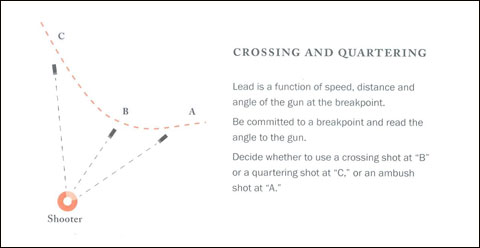
If the shooter wants his breakpoint at “A” or “B,” the target is a crossing shot, not a quartering shot. This target has a little turn-back and, even though it is a shallow turn, it is still crossing right to the left at “A” and “B” and demands some forward allowance but less at “B” than “A.” If the shooter elects to extend his breakpoint to “C,” it becomes a quartering shot, needing little to no perceived forward allowance (page 127).
“Frankly, it took years before the book took shape as a finished manuscript.” Mike said. “Warren and I wrestled everything to the ground many times. It took a lot of work and time to make it a detailed, well-organized, easy-to-follow, complete instructional guide that could impart Warren’s impeccable training process.”
As the manuscript began to take shape, they decided to work with sports photographer Chip Bromfield on the instructional photos.
“We wanted to make sure that the book also had photographs of people having fun with the sport – and, of course, dogs,” Mike said.
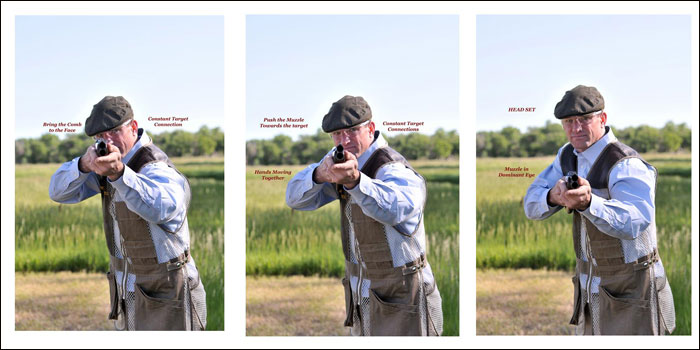 Three ways to mount a gun (pages 40-41).
Three ways to mount a gun (pages 40-41).Once things started to come together, they hired an editor, a book designer and a graphic designer for the diagrams. The goal was to produce a book that was a polished, durable, handsome and valuable guide for shotgunners at every level.
Mike summed it up by saying “We wanted to create something of value.”
He explained that Chapter 7, on the Pre-Shot Routine, is where the book shifts from the physical to the mental to teach the essential and powerful disciplines for control that come with a competent pre-shot routine. For beginners, there is often surprise about just how much mental preparation is involved. Warren drilled into his students the message that a serious shotgunner does their routine exactly the same way every time before initiating action. And it gets results because the structure builds confidence and reduces nervousness.
 Indexing the breakpoint (pages 44-45).
Indexing the breakpoint (pages 44-45).
But Mike was quick to point out that the book gets into some esoterica most shotgunners may not be familiar with. For example, he cited “a very detailed description and illustration of the technique `four back and four down.́ You might remember that the winner of a big tournament in Abu Dhabi won using that technique. There is a lot in that chapter for accomplished shooters.”
Given the cross section of shooters that the book would address, Mike and Warren felt it would be extremely useful to include a section about equipment.
“Our approach was to have a reasonably complete overview of the most common options of shotguns, with the perspective of what to consider for the individual’s comfort and success in the sport,” Mike elaborated. “There are lists about general gun fitting considerations as well as sections on specifics like a Monte Carlo stock, patterns at altitude, the hot core. In the same chapter, we discuss ways to minimize injuries from recoil.
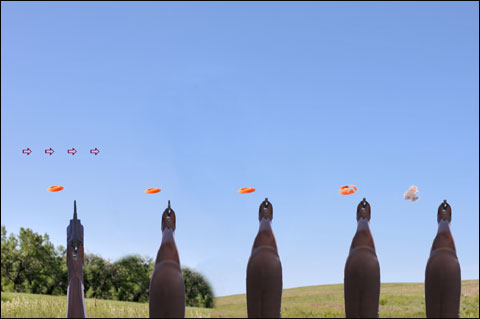 Illustrating the pass-through method of shooting (page 70).
Illustrating the pass-through method of shooting (page 70).In a way, getting back to the genesis of the book, Chapter 15 includes special guidance for women shooters, beginners, and especially young beginners.
“One important thing for all new shooters, and especially for women, is to learn is how to keep from getting hurt from recoil,” Mike explained. “A big part of it is having the right gun fit because the shoulder pockets of women are different and the toe of the stock often digs in, causing painful recoil. Having a gun specifically designed for women and the advice of a good gun fitter can make all the difference.”
“Shotgunning in the Automatic Mind – A Guide for Shotgunners and Instructors” was a long-term endeavor that bonded two men who came at the sport from different places in life yet with a firm commitment to the project.
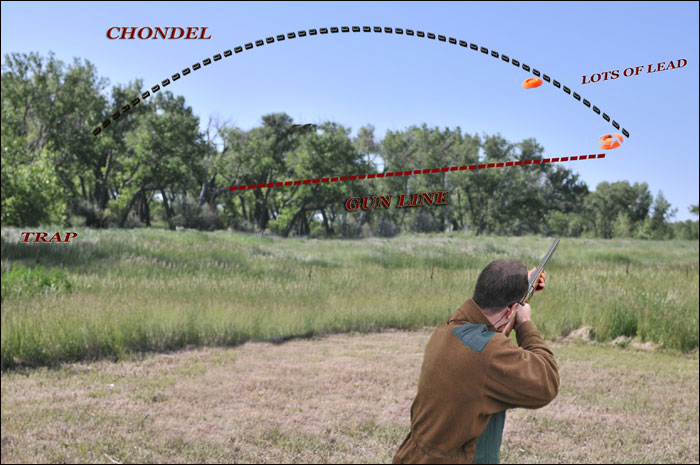
Be aware that chondel targets are rabbit targets launched into the air. Rabbit targets are heavier and have no cup to catch air and slow the target down as you would find with a standard clay target. Execute an intercepting line to the breakpoint, perhaps with a sustained lead method or a modified sustained lead technique from below the target line. Don’t track this target (page 122).
Warren woke up thinking about shotgunning, taught shotgunning all day, and went to sleep thinking about shotgunning. His devotion to the sport was total. Mike’s perspective on the sport was not as intense, but in the end it was obvious that a book captured his analytical, intuitive, and learned insights to the shotgunning sports they both loved.
“Shotgunning in the Automatic Mind – A Guide for Shotgunners and Instructors” was published in the Fall of 2019 and immediately garnered rave reviews.
Sadly, in early June of 2020, Warren died of heart failure. He was immensely proud of the book as his legacy to the sport that was his lifelong passion.
Irwin Greenstein is the publisher of Shotgun Life. You can reach him at contact@shotgunlife.com.
Useful resources:
The web site for “Shotgunning in the Automatic Mind – A Guide for Shotgunners and Instructors.”

Irwin Greenstein is Publisher of Shotgun Life. Please send your comments to letters@shotgunlife.com.


Comments